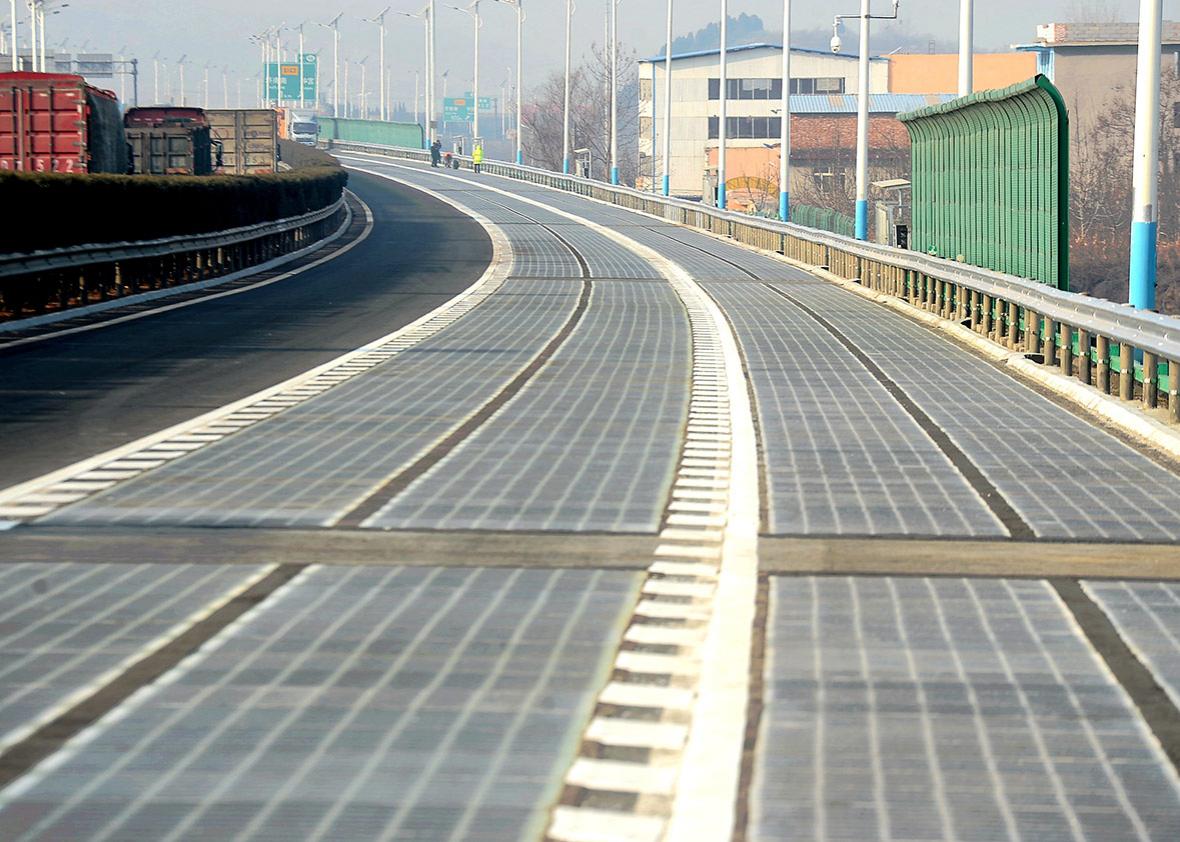China has the strange distinction of being both the world’s biggest carbon dioxide emitter and the premiere solar energy producer (Trump being in office has really given them an opportunity to firmly solidify that second crown). On Thursday, the country took its latest solar energy leap by opening a new, kilometer-long solar highway in the northeastern Shangdon province. Despite some previous attempts by other countries, it’s being hailed as the “world’s first solar-powered highway.”
The roadway, made of a transparent concrete on top, solar panels underneath, and an insulation material as the base, covers about 5,875 square feet of total space. The engineers of the project claim it’s enough to generate about 1 gigawatt of energy over a year to be used to keep street lights running and a snow-melting system for the road charged up, with plans to power future charging stations for electric cars. There are two lanes plus an emergency lane for traffic to move through, and the pavement can purportedly handle 10 times more pressure than standard asphalt.
Cool, right? Well, kind of. Solar roads might seem like a novel idea—turning every road into a solar energy–generating platform seems downright utopic. But there are pitfalls inherent to the concept. If the goal behind such a scheme is to create energy infrastructure that’s sustainable, affordable, and safe, then the Shangdon project is a pretty robust piece of evidence for why solar roads miss the mark on all fronts.
Let’s start with cost. The road costs about $458 per square meter—far pricier than the $5 per square meter it costs to create an asphalt road. That creates a price tag of nearly $2.7 million for the Shangdon project—all to generate enough electricity to power roughly 93 American homes annually. Meanwhile, the average annual cost of electricity for a single American home is a little over $1,350—or $125,000 for 93 homes. So, no, it’s not a cost-effective project. Of course, it’s a pilot project, so maybe this is OK—particularly if it paves the way (pardon the pun) for more solar roads in the future.
Except solar roads aren’t particularly efficient. Ever wonder why so many solar panels are installed at an angle? The orientation helps optimize how much sunlight hits the panels. Solar road panels, of course, need to be laid flat. Light can’t pierce through shade created by nearby trees, or buildings, or dirt that covers up the pavement. The cars themselves are a major obstacle to the light anyway, especially during a traffic jam or rush hour. And lastly, solar panels need ventilation to keep cool and perform optimally. If they get too hot, they won’t generate as much electricity.
But even all this is moot compared to the single biggest issue that most people will raise if solar roads ever go vogue: safety. Solar roads mean driving on transparent surfaces. This could mean smooth glass, or something that mixes rock and glassy materials. The transparency required for light reduces the amount of gravel and rock that could give the road enough friction to help with smooth driving. The more glassy materials you add to the road, the more you risk cars losing traction on the surface, especially in rain or snow.
So then what’s the point of a solar road? It’s not totally clear. These initial testbeds, in China and elsewhere like France, might be key to making solar roads cheaper and efficient, and verifying the safety of these stretches. Solar power is clearly the future of renewable energy for the world, and China’s advances in the realm are laudable. And who knows, maybe a solar road will eventually lead to a discovery that pays off.
But I can’t help but feel that a solar road reeks of too much hype and spectacle, and not enough practicality. Lining up the sides of highways with solar arrays might seem quaint and boring, but there’s no question it’s a much more effective way to augment solar energy production.
